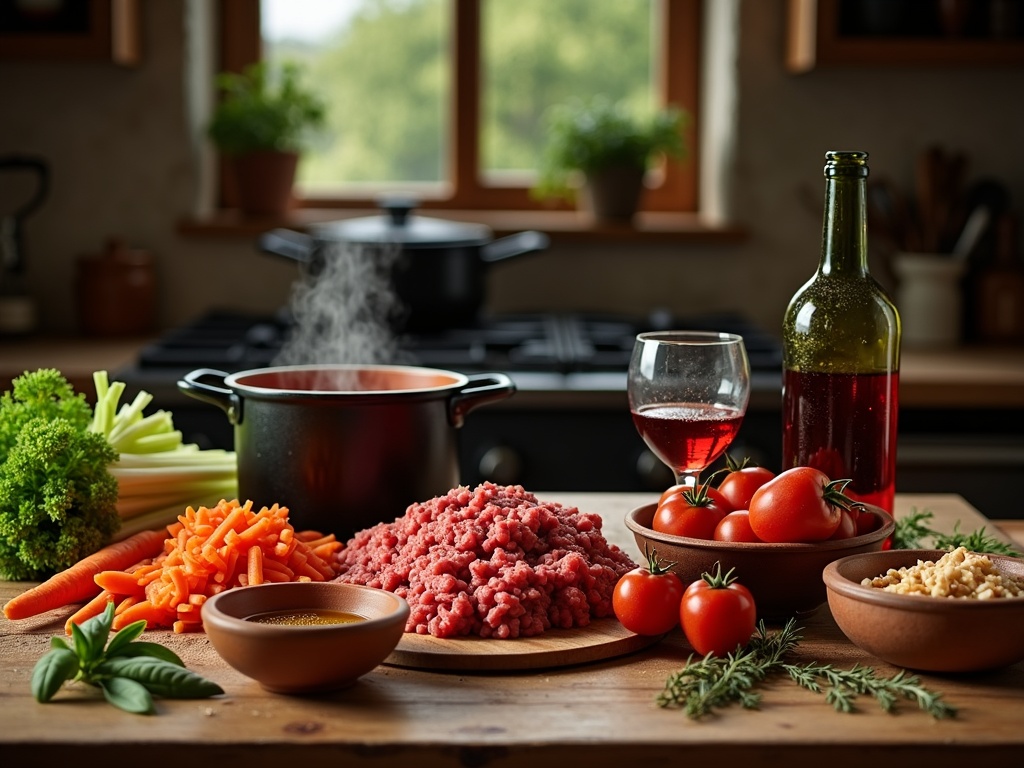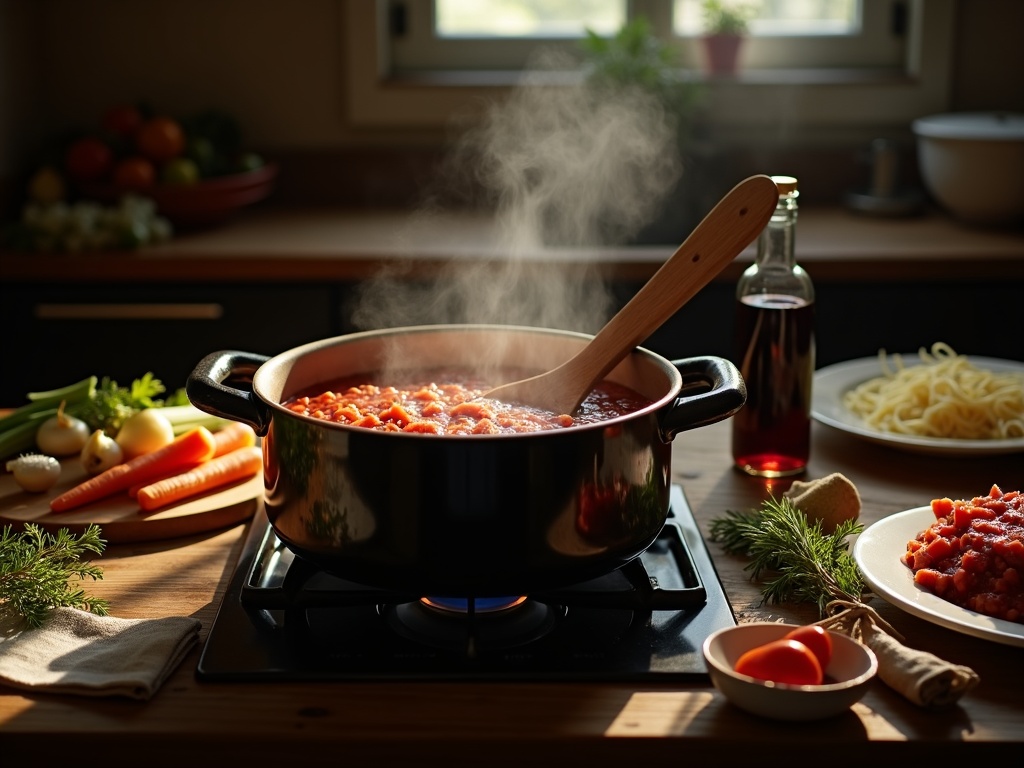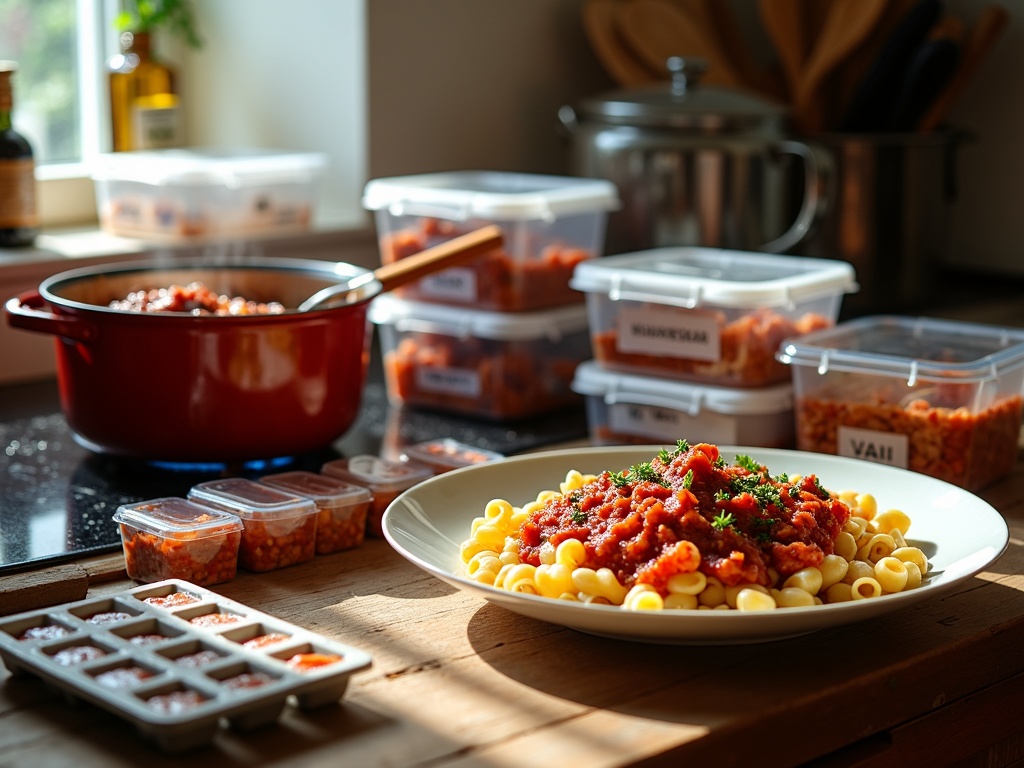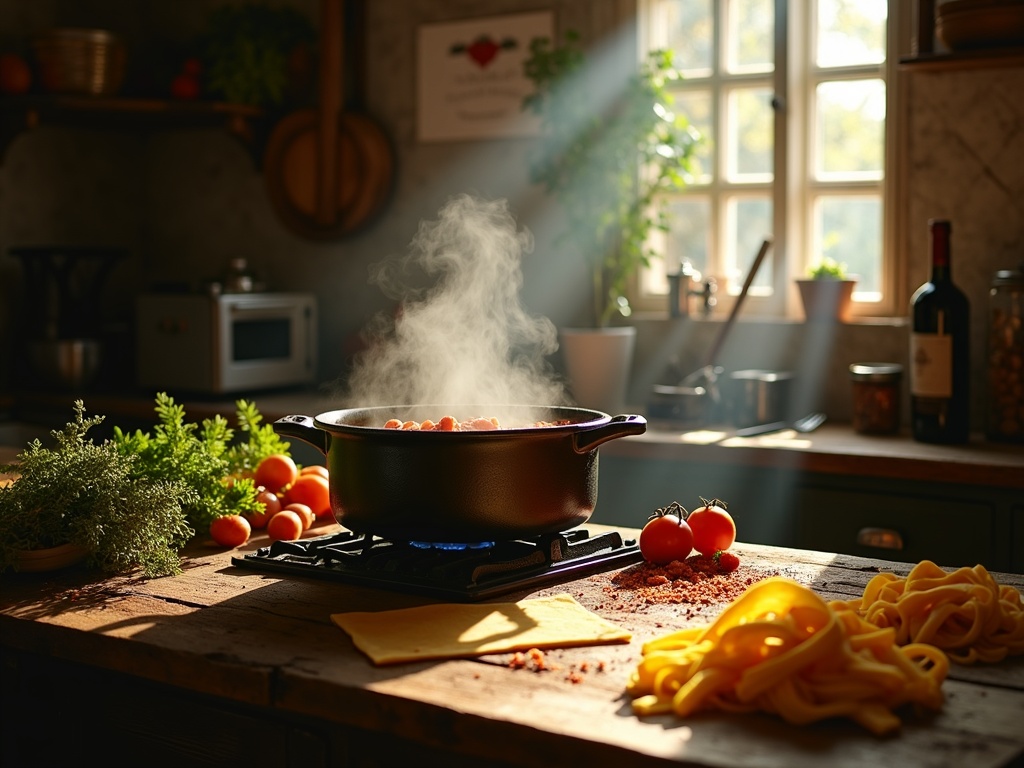Ragu recipe, the iconic Italian meat sauce, transforms simple ingredients into a rich, flavorful pasta companion through slow cooking, patience, and technique. This beloved sauce showcases Italy’s regional diversity while highlighting the cultural importance of family meals and traditional cooking methods.
Find In This Article
Key Takeaways
- Quality ingredients are essential—soffritto (onions, carrots, celery), ground meats with adequate fat content, tomatoes, red wine, and fresh herbs create the foundation for authentic ragu.
- The slow cooking process (3–4 hours minimum) is non-negotiable for developing proper flavor and texture as ingredients meld together.
- Wide, flat pastas like pappardelle and tagliatelle are traditional pairings, while ridged pastas like rigatoni offer excellent sauce-holding alternatives.
- Ragu actually improves with time—making it 1–2 days ahead allows flavors to develop more fully before serving.
- Proper storage extends enjoyment—refrigerate for up to 4 days or freeze in portion-sized containers for convenient meals up to 3 months later.
The Rich History Behind Italian Ragu
Italian Ragu isn’t just a sauce—it’s a culinary tradition steeped in centuries of history and family gatherings. This iconic sauce originated in households across Italy, where families would slow-cook meat with vegetables, herbs, and sometimes wine to create a deeply flavorful accompaniment to pasta.
From Humble Origins to Beloved Classic
The story of ragu begins with resourceful Italian cooks making the most of what they had. In earlier centuries, meat was often a luxury, so families would extend small amounts by cooking it slowly with vegetables and broth, creating a sauce that gained richness and depth over hours of simmering. This practical approach produced extraordinary flavor from ordinary ingredients.
Different regions developed their own distinctive versions based on local ingredients and traditions:
- Northern Italy’s ragu, especially from Bologna, features finely minced meat, milk, and white wine, forming the foundation for the famous Bolognese sauce many know today.
- Southern Italian versions, like those from Naples, often incorporate more tomatoes and red wine, resulting in a brighter, more acidic flavor, similar to what you might find in a puttanesca or other southern Italian sauces.
What truly sets ragu apart is its cultural significance. Sunday ragu represented more than food—it symbolized family unity. The tradition of gathering around a table while a pot of ragu simmered on the stove created memories that transcended generations. Understanding this cultural context enhances appreciation for what might otherwise seem like “just” a meat sauce.
The sauce’s importance in Italian cuisine can’t be overstated. It forms the backbone of countless Italian dishes that have gone on to international fame, including:
- Lasagna
- Tagliatelle al ragù
- Pappardelle with wild boar ragu
Its influence spreads far beyond Italy, with adaptations appearing in cuisines worldwide. This slow-cooked treasure reminds us that great cooking often isn’t about complexity but patience—allowing simple ingredients to transform into something magnificent over time.
The essence of ragu isn’t found in fancy techniques but in the care and attention given to each step of the process, honoring traditions passed down through generations of Italian kitchens.
Essential Ingredients For An Authentic Ragu
The heart of any authentic Italian ragu lies in its carefully selected ingredients. Getting these components right makes all the difference between an ordinary meat sauce and a memorable, rich ragu that clings perfectly to pasta.
The Foundation of Flavor
I start with high-quality ground meats as the cornerstone of my ragu. Traditionally, either ground beef or pork—or preferably a combination of both—provides the essential richness and depth. The fat content in these meats slowly renders during cooking, infusing the sauce with incredible flavor and velvety texture.
The classic Italian soffritto (the aromatic base) consists of:
- Finely diced onions that caramelize beautifully
- Carrots that add natural sweetness
- Celery that contributes subtle earthy notes
These vegetables aren’t just fillers—they’re crucial flavor builders that provide sweetness and complexity when sautéed until soft and golden.
Crushed tomatoes bring the necessary acidity and body to balance the richness of the meat. I find San Marzano tomatoes offer exceptional flavor, though any good-quality crushed tomatoes will work nicely.
A generous splash of red wine is essential for deglazing the pan after browning the meat and vegetables. This step isn’t just practical—it adds remarkable depth and complexity to the final sauce. The alcohol cooks off completely, leaving behind concentrated flavor compounds that transform a good bolognese sauce into an extraordinary one.
Fresh herbs elevate the sauce to another level. Bay leaves infuse a subtle woodsy note during the slow simmer, while fresh thyme adds aromatic complexity. Unlike other Italian sauces like puttanesca that rely heavily on basil, authentic ragu typically uses more earthy herbs.
The finishing touches matter tremendously. A generous drizzle of high-quality olive oil added toward the end of cooking provides silkiness and richness. Salt and freshly ground black pepper should be added gradually throughout the cooking process, allowing you to build layers of flavor rather than correcting seasoning at the end.
What makes these ingredients special isn’t just their individual qualities but how they transform during the long, slow cooking process—melding together to create something far greater than the sum of their parts.

Creating The Perfect Ragu Step By Step
The key to an amazing ragu lies in patience and technique. I’ve perfected this classic Italian meat sauce over years of testing, and I’m excited to share my step-by-step method that delivers deep, rich flavors every time. Unlike quick pasta sauces, a proper ragu develops its character through slow cooking and careful attention to each stage of the process.
Prep and Building the Base
Starting with properly prepared vegetables creates the foundation for a flavorful ragu. I always begin by finely dicing my soffritto—the aromatic base of onions, carrots, and celery. The size matters here; aim for pieces about 1/4 inch or smaller to ensure they melt into the sauce during cooking.
Here’s how I build the perfect base:
- Heat a heavy-bottomed pot with olive oil and a small knob of butter
- Add the diced vegetables with a pinch of salt to draw out moisture
- Cook on medium-low heat for 10-15 minutes until soft and translucent
- Look for golden edges on the vegetables, but avoid browning them too much
Once the vegetables have softened, it’s time for the meat—typically a 50/50 mix of ground beef and pork for a balanced flavor. I break the meat into small pieces as it cooks, ensuring every morsel browns properly. This browning process isn’t just cooking; it’s creating the deep flavors through the Maillard reaction that gives an authentic bolognese sauce its signature taste.
Layering Flavors and the Long Simmer
The next crucial step is deglazing with red wine. I pour about a cup of dry red wine into the pot, scraping up all those flavorful brown bits from the bottom. The wine should reduce by half before moving forward—this concentrates the flavors and cooks off the alcohol.
Now for the tomatoes. For a traditional ragu, I add:
- Two 28-ounce cans of whole peeled tomatoes, crushed by hand
- Two tablespoons of tomato paste for depth and umami
- A bay leaf and sprigs of fresh thyme tied together
- A small piece of Parmesan rind for extra richness
Once everything is combined, I bring the sauce to a gentle bubble, then immediately reduce to the lowest possible simmer. This is where patience becomes essential in creating stunning Italian dishes with authentic flavor. A proper ragu needs at least 3-4 hours of gentle cooking, with occasional stirring to prevent sticking.
The long, slow simmer is what transforms individual ingredients into a cohesive, velvety sauce. During this time, I keep the lid slightly ajar to allow gentle reduction and concentration of flavors. Unlike a puttanesca sauce which comes together quickly, ragu develops its magic through time.
Throughout the cooking process, I taste and adjust seasonings. The sauce may need more salt as it reduces, or perhaps a touch more herbs. I find the flavor evolves significantly during cooking—what tastes perfect at hour two might need adjustments by hour three.
In the final hour, I make sure the consistency is right. A perfect ragu should coat pasta beautifully—not too watery, not too thick. If it’s reducing too quickly, I add a splash of broth or water. If it’s too loose, I leave the lid off to encourage reduction.
The finished ragu should have a deep red-brown color, with the meat and vegetables completely integrated into a smooth, rich sauce. When you taste it, you should notice layers of flavor—first the sweetness from the vegetables, then the savory depth from the meat, followed by the complex notes from the wine and herbs.
Common Mistakes When Making Ragu
Creating a perfect ragu demands patience and attention to detail. After making countless batches over the years, I’ve identified several pitfalls that can turn this Italian classic from extraordinary to ordinary. Avoiding these common mistakes will elevate your sauce from good to memorable.
Rushing the Process
The number one error I see home cooks make is trying to speed up the cooking time. Authentic ragu isn’t fast food—it’s a labor of love that rewards patience. The magic happens during those hours of gentle simmering when flavors meld and intensify.
When you rush:
- Meat remains tough instead of breaking down into tender morsels
- Vegetables don’t fully release their sweetness
- The sauce lacks that rich, complex flavor profile that makes traditional Bolognese sauce so amazing
I’ve found that a minimum of 3 hours simmering time makes all the difference—and some of my best results come from batches that have simmered for 4-5 hours. The transformation is remarkable as the sauce reduces, thickens, and develops that characteristic silky texture.
Ingredient and Technique Missteps
Using only lean meat is a mistake I made early in my cooking journey. While it might seem healthier, ragu needs some fat to create that luscious mouthfeel. I opt for a mix of ground beef with at least 15% fat content and often add ground pork for extra richness. This combination creates the foundation for many authentic Italian dishes that rely on a flavorful meat sauce.
Skipping the wine reduction step is another oversight that costs you flavor. When you add wine to your ragu, take the time to let it reduce completely until the alcohol evaporates. This process concentrates the wine’s fruity notes while eliminating any harsh alcoholic bite. The difference in depth and complexity is striking.
Texture problems often stem from poorly chopped vegetables. I’ve learned to dice my soffritto (onions, carrots, celery) finely and uniformly.
- Large, irregular chunks create an uneven sauce
- Some bites are overpowered by vegetable pieces
- Vegetables should integrate completely as flavor foundations
Over-seasoning early in the cooking process has ruined many promising ragus. As the sauce reduces, flavors concentrate—what starts as perfectly seasoned becomes overwhelming by the end.
- Add minimal salt at the beginning
- Taste and adjust throughout the cooking process
- Do the final seasoning in the last 30 minutes
This approach works equally well for variations like puttanesca sauce or any slow-cooked Italian sauce.
Properly stirring your ragu matters too. I’ve found that sporadic stirring leads to scorching at the bottom while excessive agitation breaks down the meat too much. The sweet spot is gentle stirring every 20-30 minutes, checking that nothing is sticking and giving ingredients time to marry together naturally.
The final texture of your ragu should be moist but not watery. If your sauce seems too thin after hours of cooking, resist the urge to crank up the heat. Instead, remove the lid and continue simmering gently to allow natural reduction. Conversely, if it’s too thick, a small splash of broth (never water) brings it back to the ideal consistency.
Following these guidelines helps avoid disappointment and ensures your ragu delivers that rich, complex flavor profile that makes this sauce so beloved throughout Italian cuisine.
Tips For The Best Ragu Experience
Creating an exceptional ragu isn’t just about following a recipe – it’s about understanding the little details that elevate this classic Italian sauce from good to absolutely memorable. These practical tips have helped me perfect my authentic Italian ragu over the years, and they’ll help you too.
Ingredient Selection and Preparation
The foundation of any great ragu starts with selecting the right ingredients. When choosing meat, I opt for cuts with moderate fat content – around 20% fat creates the perfect balance. Too lean and your sauce might taste dry; too fatty and it becomes greasy. Ground chuck or a mix of beef and pork works beautifully.
I’ve found that bringing all ingredients to room temperature before cooking makes a significant difference. Cold ingredients can lower the pan temperature unpredictably, affecting how the meat browns and how the flavors develop. I take the meat out of the refrigerator about 30 minutes before cooking and let my vegetables sit on the counter while prepping.
For the best flavor development, these preparation steps are essential:
- Finely dice your mirepoix (carrots, celery, onion) to ensure they melt into the sauce
- Use a heavy-bottomed pot that distributes heat evenly
- Pat your meat dry before browning to avoid steaming
- Allow each ingredient its proper cooking time before adding the next
Patience in Cooking
The cooking technique for ragu is just as important as the ingredients. Unlike quick sauces like puttanesca, ragu demands patience. I always cook my ragu low and slow – typically 3-4 hours at a bare simmer. This allows the collagen in the meat to break down completely, creating that signature silky texture that clings perfectly to pasta.
Continuous tasting throughout the cooking process has saved my ragu countless times. Flavors change as the sauce reduces, so I taste and adjust seasonings regularly. A pinch of salt or a splash of wine at the right moment can transform the entire dish.
Let It Rest
One mistake I often see is serving ragu immediately after cooking. I always let my Bolognese sauce rest for at least 15-30 minutes off the heat before serving. This resting period allows the flavors to meld together and deepen. For even better results, I make my ragu a day ahead – the flavor improvement is remarkable after it’s had time to rest overnight in the refrigerator.
The Final Touch
The final touch when serving ragu is to marry it with the pasta properly. I add the cooked pasta directly to the sauce with a splash of pasta water, then toss everything together over medium heat for about a minute. This step ensures each pasta strand gets evenly coated with the rich sauce.
Remember that authentic ragu isn’t meant to be a quick weeknight meal – it’s a labor of love that rewards patience. The slow simmer allows the complex flavors to develop fully, creating a sauce with incredible depth that you simply can’t rush. When I take the time to follow these tips, the result is always a comforting, deeply satisfying meal that celebrates the true essence of Italian cooking.

Best Pasta Pairings For Your Ragu
Creating a delicious ragu sauce is only half the journey to an exceptional Italian meal. The pasta you choose to pair with your rich, meaty sauce can dramatically impact the overall dining experience. The right pasta shape catches and holds the sauce perfectly, ensuring every bite delivers a harmonious blend of flavors.
Wide, Flat Pasta Options
Wide, flat pasta varieties are the traditional choice for ragu, and for good reason. Their broad surface area provides the perfect canvas for the hearty sauce to cling to.
- Pappardelle stands out as perhaps the most classic pairing with ragu. These wide ribbons (typically about 1-inch wide) have the substantial structure needed to support the weight of a meat-based sauce without getting lost beneath it. The broad surface creates the ideal sauce-to-pasta ratio in each forkful.
- Tagliatelle offers a slightly narrower alternative that maintains the same benefits. This egg-based pasta from Bologna is the traditional partner for an authentic Bolognese sauce recipe, which is a specific type of ragu. The slightly rough texture of fresh tagliatelle creates tiny ridges that the sauce clings to beautifully.
- Fettuccine, while narrower still, follows the same principle. Its flat surface provides excellent sauce adhesion, making it another solid choice, particularly for slightly lighter ragu variations. I find this option works especially well when serving guests who might be intimidated by the wider pasta shapes.
Ridged and Tubular Shapes
While flat pastas have their merits, don’t overlook the textured and tubular varieties that offer different but equally satisfying ways to enjoy your ragu:
- Rigatoni‘s large, tube-like shape with ridged exteriors creates the perfect vessels for catching chunks of meat and pools of sauce. Each bite delivers an explosion of flavor as the sauce collects both inside the tubes and along the textured exterior. This makes rigatoni particularly good for chunky, rustic ragus with larger pieces of meat.
- Penne rigate works on a similar principle but in a smaller format. The diagonal cuts at each end create additional edges for sauce to cling to, while the ridged exterior holds the sauce beautifully. This shape works well for slightly smoother ragu variations.
- Fusilli‘s spiral shape effectively traps the sauce within its corkscrew curves. The twists provide numerous nooks for the sauce to nestle into, ensuring a consistent flavor in each bite. This makes it a great choice for family meals with Italian dishes like ragu, as the sauce stays put on the pasta even when served by less careful hands.
- For something different, consider shell-shaped conchiglie, which cradle the sauce within their curved forms. The larger varieties can hold small chunks of meat and vegetables from your ragu, creating perfect bite-sized flavor bombs.
- While not traditional, I’ve found that orecchiette (“little ears”) can work wonderfully with a finer-ground ragu. Their unique bowl-like shape captures the sauce perfectly, though they’re better suited to ragus without large meat chunks.
Whatever pasta you select, cook it just shy of al dente when pairing with ragu, then finish cooking it directly in the sauce for a minute or two. This allows the pasta to absorb some of the sauce’s flavor while completing its cooking process. The result will be far superior to simply topping fully cooked pasta with sauce.
For an interesting variation, try pairing your next puttanesca sauce with one of these pasta shapes as well—the principles of good sauce adhesion apply to many Italian sauces beyond ragu.
Storing And Reheating Your Ragu
After preparing a delicious batch of ragu, proper storage ensures you’ll enjoy its rich flavors for days or even months to come. I’ve found that taking a few simple steps can maintain the sauce’s quality and make future meals quick and convenient.
Refrigerating Your Ragu
When storing ragu in the refrigerator, I always transfer it to an airtight container once it has cooled to room temperature. This prevents bacteria growth and keeps other refrigerator odors from affecting the sauce. The ragu stays fresh for up to four days when properly refrigerated. For easy meal planning, I label containers with the date they were made to track freshness.
Good quality glass containers work exceptionally well for storing tomato-based sauces like traditional bolognese ragu since they don’t stain or retain flavors like plastic sometimes can.
Freezing For Long-Term Storage
Freezing ragu extends its life significantly and provides ready-made meals for busy nights. Here’s how I approach freezing:
- Portion the sauce into meal-sized containers or freezer bags
- Remove as much air as possible before sealing
- Label each container with the date and contents
- Store flat to maximize freezer space
- Use frozen ragu within 3-4 months for best quality
I’ve discovered that freezing ragu in ice cube trays then transferring to freezer bags creates perfect portions for individual servings or for adding to other Italian dishes like lasagna.
When it’s time to reheat your ragu, patience is key. I prefer thawing frozen sauce overnight in the refrigerator before reheating. Warming the sauce slowly over low heat preserves its texture and flavor profile. If the sauce has thickened too much during storage, I add small amounts of water, stock, or wine to achieve the desired consistency.
For quick meals, I often pair reheated ragu with freshly cooked pasta or use it as a base for other dishes like puttanesca sauce by adding capers and olives for a different flavor profile.
Remember to stir occasionally while reheating to prevent the sauce from sticking to the bottom of the pan or developing a film on top. The gentle approach to rewarming helps maintain the complex flavors that developed during the initial cooking process.

Making Ragu Ahead Of Time
Preparing ragu in advance isn’t just a time-saving strategy—it actually improves the flavor profile of this classic Italian sauce. The robust ingredients in ragu benefit tremendously from having extra time to meld together, creating a deeper and more complex taste experience.
Storage and Preparation Tips
I’ve found that making ragu a day or two before serving allows the flavors to develop beautifully. The meat becomes more tender while the herbs and spices integrate more fully into the sauce. To prepare ragu ahead of time, I recommend cooling it completely after cooking, then dividing it into portion-sized containers. This approach makes it easy to grab just what you need later on.
For refrigerator storage, ragu keeps well for 3–4 days in airtight containers. If you’re planning for longer storage, freezing is a fantastic option. Ragu freezes exceptionally well for up to three months. I like to label each container with the date so I can keep track of freshness.
Reheating For Maximum Flavor
When it’s time to enjoy your prepared ragu, the reheating process is crucial for maintaining quality. I prefer gentle reheating methods to prevent the sauce from breaking down or burning:
- For stovetop reheating, use a heavy-bottomed pan on low-medium heat and stir occasionally
- Add a small splash of broth or water if the sauce has thickened too much during storage
- Allow the sauce to come up to temperature slowly rather than rushing the process
This technique works perfectly whether you’re serving a traditional Bolognese sauce or experimenting with other Italian dishes like a spicy puttanesca sauce.
The beauty of making ragu ahead of time is that you get the best of both worlds: convenience and enhanced flavor. There’s something truly satisfying about pulling a homemade sauce from the refrigerator or freezer and enjoying a meal that tastes like you spent hours preparing it that very day. The sauce develops character during its rest period, often tasting even better than when freshly made.

